Menus
- Middle class naked bikes with 2-, 3- and 4-cylinder engines
- Two-cylinder
- Noticeable and audible switching shocks
- Aprilia accelerates (almost) better than any Porsche
- Touring package for BMW F 800 R.
- Three-cylinder
- Exhaust moves to the basement
- Performance is delayed, but then brutal
- You have to be wide awake at all times on the Brutale
- Everything fits together at Triumph
- Four-cylinder
- FZ8 with variable rebound damping
- FZ8 and Aprilia red lanterns in the pull-through test
- Conclusion / test results
- MOTORCYCLE scoring
- Technical data: Aprilia, BMW
- Technical data: MV Agusta, Triumph
- Technical data: Kawasaki, Suzuki, Yamaha

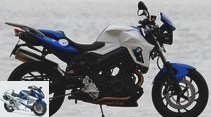
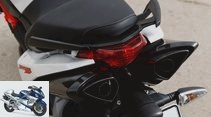

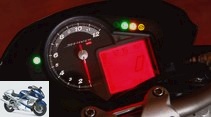
37 photos
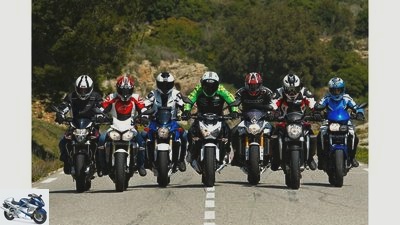
1/37
Aprilia Shiver 750 ABS, Triumph Street Triple 675, Suzuki GSR 750, Kawasaki Z800, Yamaha FZ8, MV Agusta Brutale 800 and BMW F 800 R in comparison test.
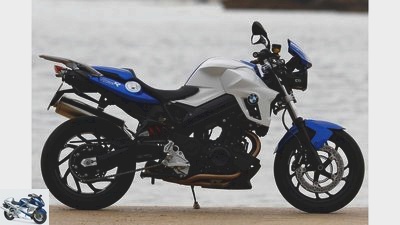
2/37
BMW F 800 R: Bavaria’s successful midrange roadster combines everyday and touring suitability with a dash of sporting spirit. Its in-line twin sounds like a tuned BMW boxer.
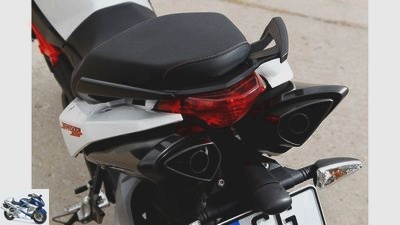
3/37
The last of their kind: sleek underseat exhausts – bassy, but heavy and unfavorable.
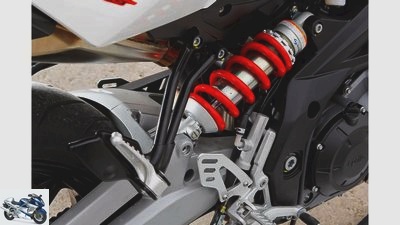
4/37
As with the BMW, the shock absorber is off-center and is directly hinged.
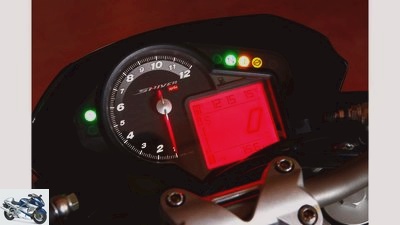
5/37
The central tachometer flanks the on-board computer with lots of information.
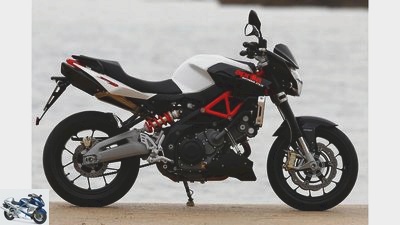
6/37
Aprilia Shiver 750 ABS: It was the best-selling Aprilia in Germany in 2012. And in this test field, the Italian produces the only V-engine. Sound and character meet good workmanship.
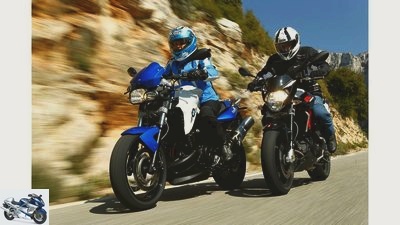
7/37
2 cylinder: BMW F 800 R and Aprilia Shiver 750 ABS.
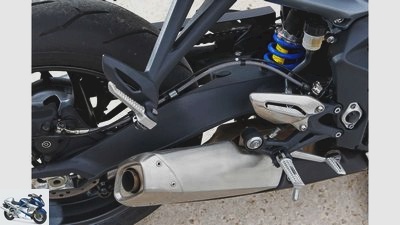
8/37
New in 2013: asymmetrical banana swingarm and deeply laid exhaust. Nicely crafted chain tensioners.
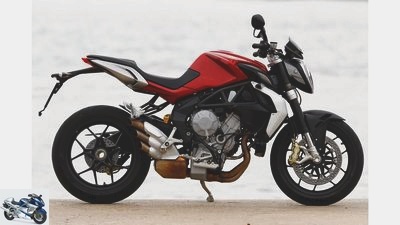
9/37
MV Agusta Brutale 800: The enlarged three-cylinder with the single-sided swing arm should be the best-selling MV. At an affordable price, it combines top driving performance with sensual charisma.
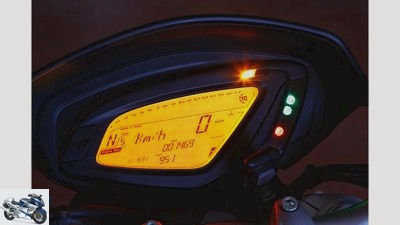
10/37
Fully digital information display with small LCD pixels and gear indicator.
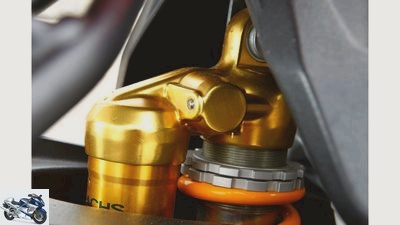
11/37
Unlike the 675 MV and the 800 competition: fully adjustable spring elements.

12/37
Own: The beautiful MV logo on the side of the tank is not painted over. The horn button sits above the turn signal switch.
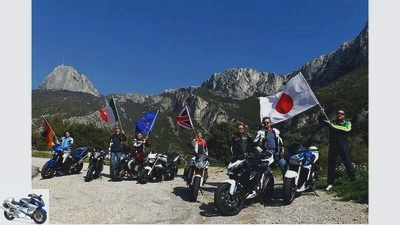
13/37
Competition of nations and concepts: Japan relies entirely on inline four-cylinder engines. The offers from Europe are more diverse and independent, as is typical of the brand. OK then!
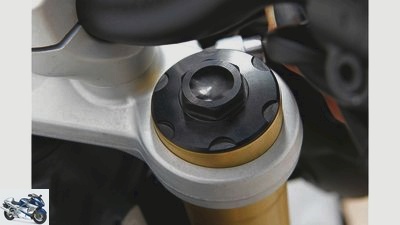
14/37
Simple: The fork of the standard Streety is not adjustable.
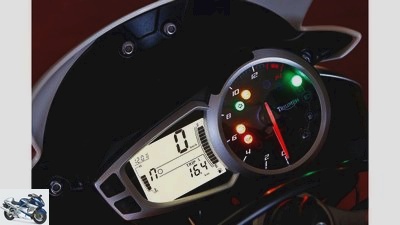
15/37
Great: extensive instruments, now with a detailed fuel gauge. Easily readable tachometer, reassuring immobilizer.
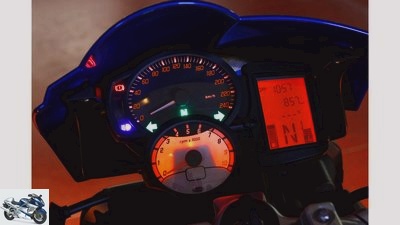
16/37
The oval clocks with needles that are both thick and short are not ideal for reading. The on-board computer with XXL gear indicator unfortunately costs an extra charge.
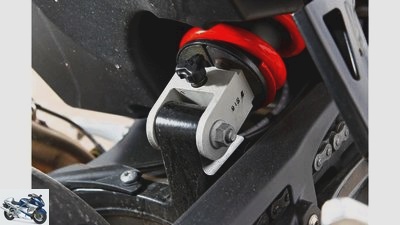
17/37
User-friendly: The spring base and rebound damping of the shock absorber can be adjusted without tools.
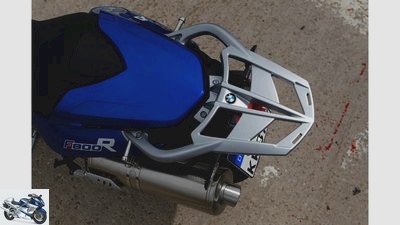
18/37
Practical and stylish: huge luggage rack with long hooks and pillion seat cover cost extra.
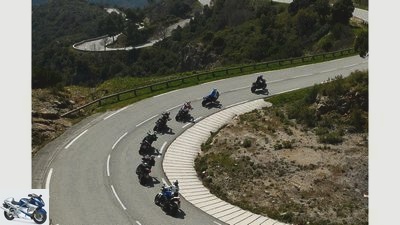
19/37
In the south of France, the field of seven competes to inhale early spring.
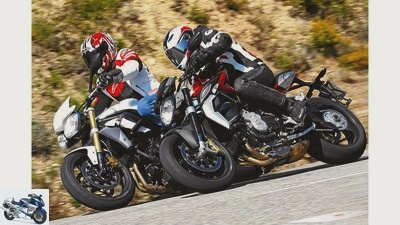
20/37
3 cylinder: Triumph Street Triple 675 and MV Agusta Brutale 800.
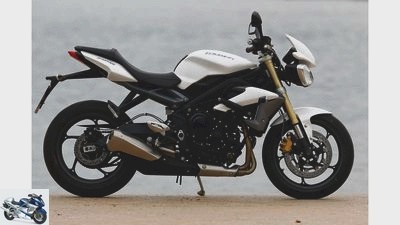
21/37
Triumph Street Triple 675: Enthusiastic professionals, delighted novice drivers. In terms of driving dynamics and emotional impact, the 675 is a big one. 2013 with ABS, your sales success is certain.

22/37
Distinguishing marks 2013: Adjustment options on the upside-down fork.
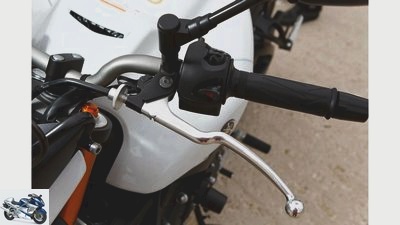
23/37
Nobody understands: With all Japanese, the clutch lever is not adjustable.
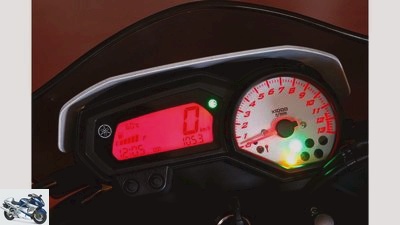
24/37
Nice: rev counter with a white background, flanked by LCD displays for additional information.
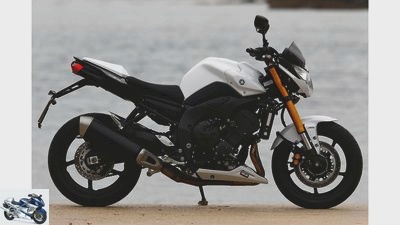
25/37
Yamaha FZ8: Only the XJ6 sold even better at Yamaha Germany in 2012. Arguments for the 800? A very mature, good-natured motorcycle that was upgraded in 2013.
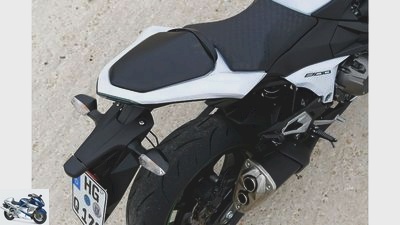
26/37
Over-designed? The angular pillion seat and the driver’s seat are not particularly comfortable. Good: luggage hook.
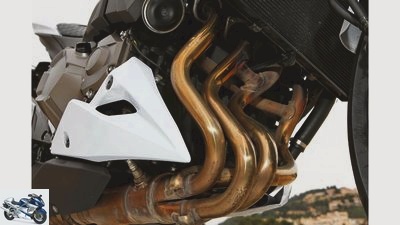
27/37
Four wins. The jagged manifold quartet has torque-promoting interference tubes.
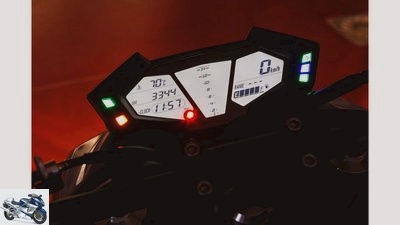
28/37
Invisible to the radar screen: unusually shaped instruments with an LCD tachometer that is very difficult to read and the most important information.
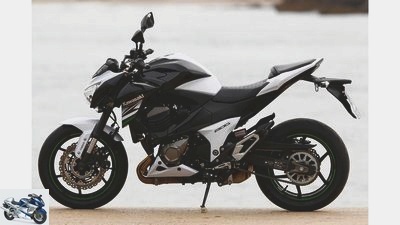
29/37
Kawasaki Z 800: The fiercely styled 800 series follows a great legacy: The Z 750 models were the best-selling Kawasakis in Europe for many years. Now there’s more manga-style steam.
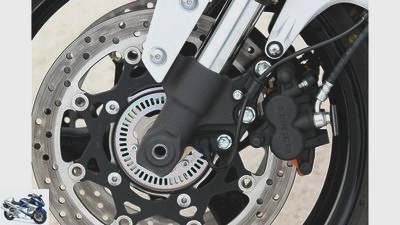
30/37
Better than the test copy in 2012: The brake pads no longer look so dull.
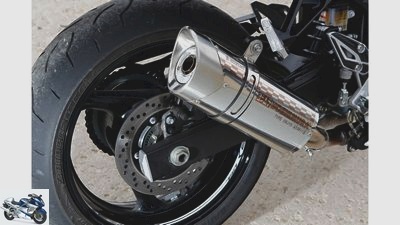
31/37
Contrasting program: very noble Yoshimura exhaust next to the cheapest swingarm.
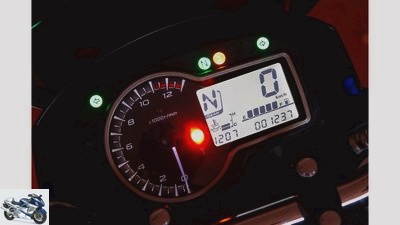
32/37
Benefit: the tachometer and gear indicator are large and easy to read.
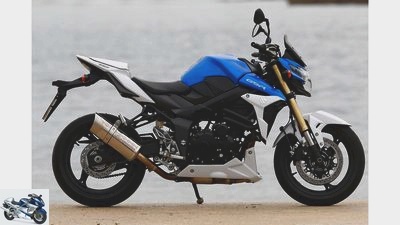
33/37
Suzuki GSR 750: Second most popular Suzuki in Germany in 2012: The 750 embodies the brand perfectly. It offers a lot of motorcycle for the money. And a lot of steam with little consumption.
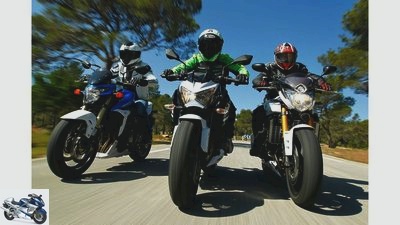
34/37
4 cylinder: Suzuki GSR 750, Kawasaki Z 800 and Yamaha FZ8.
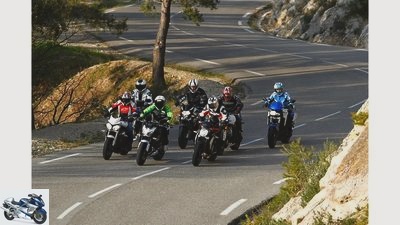
35/37
Hard to beat: little traffic, empty streets and really great motorcycles!
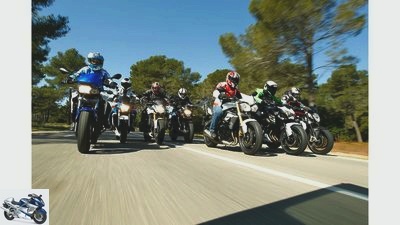
36/37
Everything stays different. Kawasaki and MV Agusta are brand new in 2013, the Triumph is strong, the FZ8 a bit overhauled.
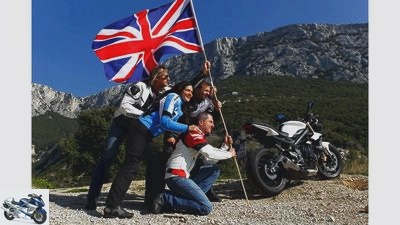
37/37
The shining winner in the end is the strong triumph. The Union Jack flutters proudly in the sky above the strengthened new middle class: Britannia rules! The revised Triumph Street Triple wins by a narrow margin, but deserves it.
Aprilia Shiver 750 ABS, BMW F 800 R, MV Agusta Brutale 800, Triumph Street Triple, Kawasaki Z 800, Suzuki GSR 740, Yamaha FZ8 in the test
Middle class naked bikes with 2-, 3- and 4-cylinder engines
A lot is happening in the successful middleweight class: In the manageable, still affordable and still fiery naked bikes up to 800 cubic meters, completely new models meet revised and well-established ones. But above all, two-, three- and four-cylinder. More variety of engines for diverse driving experiences.
Even the name goes down like oil: Roadster. Say that very slowly, with a rolling “rrr” à la Carolin Reiber. Then you can hear it out, the “Rrrooaarr” of the engines. And the call of the streets, the roads of this world. Which one likes to follow in the saddle of these seven driving machines. Naked bikes with modern designs are from Japan and Italy, Germany and Great Britain. With two-, three- and four-cylinder engines typical of the brand, officially 95 to 125 hp with moderate weight. The range extends from the delicate 186 kilograms of the MV Agusta Brutale 800 to a tolerable 231 kilograms of the Kawasaki Z 800. Key data that are more suitable for connoisseurs than for beginners.
Buy complete article

Aprilia Shiver 750 ABS, BMW F 800 R, MV Agusta Brutale 800, Triumph Street Triple, Kawasaki Z 800, Suzuki GSR 740, Yamaha FZ8 in the test
Middle class naked bikes with 2-, 3- and 4-cylinder engines
Driving pleasure without pain
All concepts are crisp, crispy and hearty, and not just thanks to individual front masks. Quite upright, sitting only slightly bent in the pure wind. Driving pleasure without pain. Fired by typical brand engines. Like the three-cylinder in-line engines on the MV and the Triumph Street Triple. For the 2013 season, the 675 was thoroughly revised and is finally available with ABS. Aprilia brings a 90-degree V2 into play, BMW a row twin, and the three Japanese rely on row fours. The Z 800 is a completely new development and the Yamaha FZ8 is entering the race with new suspension elements. That about success in individual test criteria as well as about buyer favor.
Because the already established models are real top sellers. It’s like in real life: the middle class acts as a pillar of society. And the new machines have what it takes to make it to the top within the brand. This ensures very good value for money. With base prices from a good 8,000 euros, moderately wide 180 mm rear tires as well as manifolds and mostly stainless steel exhausts. These fine volume models are real “Erfolk types”. But: Who best embodies the healthy middle between speed-hungry 600s and brutal 1000s or 1200s? The truth is naturally out there, on the street …
Two-cylinder
2 cylinders: BMW F 800 R and Aprilia Shiver 750 ABS.
Europe sets the tone: with the two-cylinder engines
North and south of the Alps, in Noale and Munich, there is agreement: it has to be a two-cylinder! But that’s where the similarities almost stop. As is typical of Italy, Aprilia relies on a 90-degree V2 in a steel, red tubular mesh with screwed-on cast parts for the swing arm. At BMW, on the other hand, a black lacquered row twin is installed, which hangs in a massive looking, black anodized aluminum bridge frame. Despite plenty of extras, the F 800 R weighs a full 13 kilograms less than the Shiver in the standard trim: 212 to 225 kilograms. Quite a factor when pushing and maneuvering.
Here as there, the tropics are not exactly small. The Aprilia looks big and powerful. Your inviting, because expansively wide driver’s seat sits 83 centimeters high, the negative record of the entire field of seven. Tester Stefan, a 1.80 meter man, gets down with both feet well: “It fits perfectly!” The BMW marks the other extreme. Your optional low bench lowers the seat height to just 79 centimeters at no additional cost. Wendy, who is only 1.60 meters tall from the USA, has no trouble climbing the seat of the Bavarian, which is painted in white and blue national colors. It sits very well integrated “in” the motorcycle and can withstand it for hours in the low saddle. Sharp knee angles on the 800? Here you go, for tall guys BMW offers a higher bench in addition to the standard bench. As compensatory justice.
Noticeable and audible switching shocks
Pressing the button is followed by an acoustic illusion: “Sounds like a BMW boxer,” remarks Wendy. Right. After all, the parallel twin ignites evenly every 360 degrees, just like the R models. Only the F sounds almost hoarse, dull, fuller. On the other hand, there is the furious V2 staccato from the two raised Aprilia mufflers. Together with the hammering from the airbox, that sounds really powerful, Ducati-like. But the BMW spoils you with the richest torque of all seven machines. From starting up to 7500 tours, no engine delivers so much power per speed, with a fat peak already at 5800 rpm. People, something is going on!
In contrast, the Aprilia falls into a small torque low at the 3000 mark, from which it works its way up only hesitantly. It always ranks between ten and 20 Newton meters below the BMW – see performance curves on the last page of the article. The V2 only looks powerful from the 5000 mark. Okay, the Aprilia has a slightly shorter translation, it turns around 4650 times in sixth gear at 100 km / h, the F 800 R does 4250 tours. Nevertheless, the Shiver can never hold a candle to the BMW. The 800 simply pulls through more confidently. Basta!
Good thing, because the top of the series twin shakes violently despite the compensating cone. In addition, it looks tough when it is turned out and gets tired early. His switching shocks can be felt and heard. Both machines have play in the drive train that is noticeable as “jerking” (tester Stefan). That doesn’t seem quite as smooth.
Aprilia accelerates (almost) better than any Porsche
Where does the good performance of the BMW come from? Well, their pistons and intake cross-sections are smaller, the stroke much larger. Good for bottom printing. Higher compression and engine management with overrun fuel cut-off are clearly noticeable when the accelerator is released: when driven on country roads in compliance with the German Road Traffic Act, it is content with an economical 4.2 liters per 100 kilometers, like the Suzuki. The Aprilia needs 4.9 liters, okay. The Italo 750 accelerates better than (almost) any Porsche – from zero to one hundred in four seconds. But all six other candidates can do it even better, especially at higher speeds. The Shiver’s powerful, purely electronically controlled 52 throttle valves are sometimes a bit rude, because they respond with a delay to gas commands. The three different mappings do not change that much.
Aprilia Shiver 750 ABS: It was the best-selling Aprilia in Germany in 2012. And in this test field, the Italian produces the only V-engine. Sound and character meet good workmanship.
What irritates the BMW: In cool temperatures, the tight steering damper causes up to 50 km / h to tumble around the longitudinal axis. The staggering only disappears when driving briskly, and the Michelin Pilot Power gives you full confidence. The feedback about what is going on under you is better than on the Shiver. The F 800 R rounds curves of all radii more manageable, more stable and more precise than the Aprilia. Quite light-footed, despite the longest wheelbase in this class. But this time a BMW does not set the best marks in the entire test field.
The chassis is too simple for that. The F 800 R carries a conventional cheap fork without adjustment options. It is more comfortable, softly tuned. The powerful front brake sometimes forces you to block. In addition, the fork speaks woody, a little sluggish. The BMW shock absorber offers a lot of comfort on normal roads. Like the Aprilia, it is directly hinged. And the only one that can be adjusted without tools. But on rough mogul slopes it reaches its limits and looks slightly trampled. The Aprilia does not drive completely neutral on bad terrain. Despite great tires, Pirelli Diablo Rosso II, it stands up noticeably on smallpox asphalt. The 750 always looks for its own lines. It seems a bit indifferent when driving briskly.
The hardly comfortable, tight Aprilia shock absorber does not respond very sensitively. The Italo front brake anchors strongly, but needs a lot of hand strength. And at the end of an emergency stop, the rear wheel can sometimes get quite high. A well-regulating ABS is standard on board here as there, at BMW only since 2013. What puts a smile on Stefan’s face on the pretty 750 Aprilia: comfortable, broad-shouldered seating position, high-quality workmanship and smart details. The brake pedal can be adjusted eccentrically, the cast aluminum swing arm with upper cables is screwed from two halves. And that as the cheapest of all test machines for 8690 euros.
Touring package for BMW F 800 R.
In 2012, the F 800 R was the third best-selling BMW in Germany after the R 1200 GS and F 800 GS. The tire valves are perfectly accessible in the spokes of the cast wheels. Another positive aspect is the air pressure control, which is subject to a surcharge. Your touring package is useful. For a moderate € 500 surcharge, it offers on-board computers, the only main stand in the test field (great for chain maintenance!) And a huge luggage rack. There is also a case holder, socket and extra-thin heated grips – welcome in the cold.
BMW F 800 R: Bavaria’s successful midrange roadster combines everyday and touring suitability with a dash of sporting spirit. Its in-line twin sounds like a tuned BMW boxer.
All of the accessories are installed and installed in a user-friendly manner in the Berlin plant. However, it drives along with hefty 390 euros ancillary costs, only Triumph demands five euros more, the price of this test F-800-R then over the magical 10,000 euros limit. But the points victory in this duel clearly goes to BMW. It combines many more advantages. Up to great touring suitability thanks to the large range and – in contrast to the Aprilia – sufficient payload. Pillion passenger? Luggage? “Pah,” says the Shiver driver, “let the others take them with them.”
Three-cylinder
3 cylinder: Triumph Street Triple 675 and MV Agusta Brutale 800.
The Golden middle? European three-cylinder
A three-cylinder belongs in every good garage. There is no doubt about that for lovers. The only question that arises is: which one? The already classic triple from Triumph or the new one from MV Agusta? The Italians are now providing their Brutale 675, which was only introduced in 2012, with a full-fledged 800 with more displacement and performance. As a bonus, there are fully adjustable spring elements for just 1100 euros extra. The luxury brand doubled its production in 2012 with the 675 three-cylinder. And the beautiful 800 Brutale will probably become the most popular MV. With 125 hp she attacks Triumph Street Triple and Speed Triple 1050.
This is where cubic capacity meets experience: the British have already turned the tried and tested 675 engine into the drive of the Tiger 800. Except that the travel enduro offers less peak performance and revving with less torque and less “kicks”. That’s why Triumph is not planning an 800-cc naked bike. No, for the more emotional Streetfighter Street Triple it stays with the lively, sporty, 106 hp 675 engine. The only changes in 2013 are a longer first gear and new ignition / injection software. What is new, however, is the appearance with a new tank, frame, rear frame and wheels – identical to the Daytona, which has also been renovated.
Exhaust moves to the basement
In addition, the exhaust moved to the lower ground floor in a much more compact form – the time of the two somewhat clunky, chubby, high-level silencers is a thing of the past. Mass centering and weight savings were the specifications. Goal achieved: 190 kilograms is the second-lightest weight in this test. Including ABS for 400 euros, the most important innovation of 2013. Only the petite MV is even lighter, weighs a delicate 186 kilos. ABS will only be available to them in the second half of 2013. Anyway, go now, sound check!
The MV sounds a bit sawy, rather high-frequency from three short organ pipes in front of the exposed rear wheel – with a noble single-sided swing arm only the Brutale trumps in the test. The Street Triple counteracts it with a hoarse gasp and a typical growl of triumph. The 675 beats bravely when driving off. Up to the 6000 mark, it stands up to the larger engine. The shorter-stroke Brutale only shows its full potential at higher speeds. At 6500 and then again at 8000 tours it rapidly increases in power, suddenly knocking the handlebars in the face in second and third gear when accelerating out of turns. Light, strong, brutal.
Performance is delayed, but then brutal
Wheelies? Old Street Triple could do better. Not bad. After all, the new one is a streetfighter for the people, one to love. He develops his performance vigorously, but super linear and predictable. Great. The MV cannot pile up more than ten, twelve Newton meters of additional torque to the Triumph at any speed. But because it has a shorter gear ratio and turns higher at the same speed, the Brutale rides in a galaxy of its own when it pulls through: 6.3 seconds in sixth gear from 60 to 140 – only few big bikes can do that so quickly. The total madness. Hold on tight! This is how Munchhausen must have felt on the cannonball.
As the most powerful machine in the septet, the 800 Brutale finally delivers real 123 hp at 11500 rpm. Pure anger. A real bundle of energy, this power-naked. Nevertheless, you don’t miss anything on the Triumph. The draft is great in itself, namely the second best. And the acceleration up to 140 km / h is absolutely equal to the brutal. Tribute to the moderately controllable clutch of MV’s power pack and its unbalanced throttle response. You never really know what the electronically operated throttle valves of the hot spur are doing. Gas on: performance is delayed, but then brutal. Gas quickly closed again: The triple pushes for a split second. Huiuijuihh. “It is dangerous to assess when and how the performance is coming,” says Wendy.
You have to be wide awake at all times on the Brutale
MV celebrates ride-by-wire as the basis for four different mappings (rain, comfort, normal, sport) and eight-stage traction control. But not a single mapping is completely convincing. Where “S” is more direct, “N” is even more delayed. The traction control intervenes rather late, insensitively. You have to be wide awake at all times on the Brutale. You praise the good old Triumph accelerator cable. The velvety 675 engine is much more manageable. And more economical.
MV Agusta Brutale 800: The enlarged three-cylinder with the single-sided swing arm should be the best-selling MV. At an affordable price, it combines top driving performance with sensual charisma.
If you drive carefully, it needs one and a half liters less fuel. “Of all seven engines, the Triumph-Triple runs the smoothest, the least vibration,” says tester Georg happily. In order to then criticize the “severe misfiring of this test machine in the partial load range”. “But only when driving in the rain.”
The streets become more winding, the curves narrower. There has hardly been another motorcycle that folds down as daringly, as easily as the MV. She plunges into the curves like a peregrine falcon on pigeons. You just think about the curve, and it turns into a corner. Telepathy on Wheels. The author is enthusiastic about this “weightless flying”. This is already overactive for sensitive drivers. Fidgeting on the wide, butted aluminum handlebars provokes nervous reactions. A bicycle, a toy and a lighter. With this Speedster, the shortest wheelbase (1.38 meters) meets the steepest steering head: 66 degrees, as with the Kawasaki. In this round, only the MV has a fully adjustable chassis. The upside-down fork works more comfortably, the rock-hard shock absorber is relentlessly taut. Synchron is different.
Triumph Street Triple 675: Enthusiastic professionals, delighted novice drivers. In terms of driving dynamics and emotional impact, the 675 is a big one. 2013 with ABS, your sales success is certain.
The Triumph is easier to drive, more user-friendly. It is more forgiving, remains more relaxed and neutral when the road construction is tough. And this despite the fact that this is our first time driving the standard version of the new Triumph Street Triple. You have to do without the nobler, fully adjustable spring elements and the four-piston brakes of the 1000 Euro more expensive “R” version. So what? The simple parts of the lowest basic price of all Triumphs (8090 euros) do it too. Their simple double-piston floating calipers decelerate reliably and properly. The 675 runs its course balanced and stable, very well balanced. Damn nimble and precise, the Triumph scurries through the curve thicket. The easy handling turns on. Even if the less top-heavy previous model folded down even more easily.
The great seating position contributes to the high comfort factor on the 675: Perfectly integrated into the action, you have the situation under control at all times. The front wheel-oriented seating position of the MV with the high footrests has a combative effect. She wants to rage, the brutal. Never leaves you alone, always demands attention. Also applies when standing, when admiring the inspiring forms (language), mostly fine details. “Sex on wheels,” says the author. Not at all sexy, on the other hand: the sloppy clutch lever, the only one in Europe that cannot be adjusted. Lap timers with lap times demonstrate sporting spirit in both triples.
Everything fits together at Triumph
It’s not just because of the ABS that the Triumph picks up every driver personality where it is. They are also available for a mini surcharge with 48 HP and A2-compliant driver’s license with 95 HP. It is a real system. Everything fits together, is more than the sum of its parts. So its main opponent is actually more the BMW F 800 R than the MV Agusta. Because the Brutale 800 remains a case for specialists, for connoisseurs and experts. It starts with the basic price, which is really cheap by MV standards, the highest of the septet in absolute terms. Continues with higher maintenance costs – 6000 instead of 10,000 maintenance intervals. But also with difficult to control throttle response and many compromises in everyday life.
Four-cylinder
4 cylinder: Suzuki GSR 750, Kawasaki Z 800 and Yamaha FZ8.
Japan’s Gloria: Fascinating four-cylinder
Almost 110 years after the first four-cylinder, the FN and the Laurin&Klement from 1904, it is still a fascinating idea to couple four bars with four cylinders in series. Such engines made the Japanese motorcycle industry big and powerful, beaming the motorcycle back to Western civilization. All four brands can look back on legendary four-cylinder models and have gathered loyal fans around them who devotedly adore type abbreviations. Because they know that with the same displacement, more cylinders enable more power. And appreciate the high degree of maturity of the proven resilient, durable engines. Drivers are those who like the calm and calming effect of this elastic drive principle. Perfect concentricity even at the lowest speeds! Jerking what is it?
Whereby one should not equate gentle with toothless – with 106 HP (Suzuki and Yamaha) to 113 HP (Kawasaki). Nippon’s three distinctive roadsters are full-blown and balanced machines. With very different histories. Suzuki sends the GSR 750 unchanged into the season. But gives the customer an accessory voucher for 600 euros on the way. Is that why the importer packed extras for almost 1,800 euros for the five-five? Test driver Gabriel, known as “the Badische Brosel”, describes this mixture as “Klimbim”: front spoiler, discreet sounding Yoshimura exhaust, chain guard with GSR logo, windshields and much more. Everything is nice, but certainly not decisive for the test. But is it crucial to buy? With all the gimmicks, the Suzuki costs as much as the MV!
FZ8 with variable rebound damping
The FZ8 also goes for accessories for almost 1000 euros: radiator cover, narrow license plate holder, engine spoiler, pillion seat cover and so on. Yamaha goes wild. The standard equipment, improved in 2013, with clear glass indicators, neatly shaped silencers and improved chassis fits well: the rebound stage damping can now also be varied in addition to the spring base on the up-side-down fork and on the shock absorber. The Kawasaki Z 800 also has it. But from the beginning. Because it is new. A good 40 years after the style-defining Z 900, it is branded aggressive, very futuristic styled. The design is tough, sharp cut.
Kawasaki Z 800: The fiercely styled 800 series follows a great legacy: The Z 750 models were the best-selling Kawasakis in Europe for many years. Now there’s more manga-style steam.
Fightingly ducked to the grim, evil looking lamp mask with a thick “lower lip”. It takes on a great legacy, the Z 800. It replaces the Z 750 models, Kawasaki’s top sellers in Europe for years. More bore pumps the displacement up to a full 806 cubic meters, the largest in this class. In addition to larger intake cross-sections, there were plenty of torque-boosting measures. These include longer intake ducts, interference pipes between the extra-long manifold pairs 1-4 and 2-3 and the increased compression of 11.9: 1. In fact, the refined four-cylinder pushes mightily. With the best pulling power of the Nippon trio and accompanied by a dull, gritty exhaust sound. Kawa-according.
A flap on the collector makes it possible. The 800 series hangs softly and beautifully directly on the gas – better than in the top test of MOTORRAD 2/2013. “The Kawa does exactly what you want,” says Sven dryly after a wheelie. This is where the dual throttle valves show their advantages. The Suzuki GSR 750 has the same effect. The second throttle valve operated by the on-board computer improves the flow conditions and thus ultimately the filling. Sounds complicated? But works quite inconspicuously. Despite the small displacement shortcomings, the Suzi competes with full pressure. And this despite the fact that it has particularly large holes in the cylinders – the largest of the Japanese pistons, combined with the smallest stroke.
FZ8 and Aprilia red lanterns in the pull-through test
In general, this is not a good recipe for particularly high torque. But with the former GSX-R engine, it works: OP completely successful. In this trio, the GSR accelerates best. Is it the weight? After all, the Suzuki is a full 17 kilograms lighter than the 231 kilograms heavy Z 800. Kawasaki Heavy Industries. Both have a heavy steel frame with a clumsily welded stern. Can easily get expensive if the worst comes to the worst. The chassis of the Z 800 is based on that of the 750 predecessor. The frame spans the side of the engine as usual, but was equipped with a finer swing arm. The Yamaha FZ8 carries a noble aluminum swing arm in the shape of a banana, the Suzuki a cheap steel box swing arm. Overall, the Yamaha is Japan‘s most valuable made representative. Not least thanks to the elegant aluminum bridge frame. However, its sonorous, sizzling silencer is made of flatly painted sheet steel.
Suzuki GSR 750: Second most popular Suzuki in Germany in 2012: The 750 embodies the brand perfectly. It offers a lot of motorcycle for the money. And a lot of steam with little consumption.
And the engine of the FZ8? He goes a little harder on the gas from the push mode. And despite the less short-stroke design, it does not come out of the push very hard. From 3800 to 6000 tours he has to line up behind the Suzuki, falls into a torque hole at 5500 rpm. Only then is there real thrust available. “Unfortunately, the drive is pretty bloodless in the lower speed range,” complains driver Sebastian. And so the FZ8, which weighs just 217 kilograms, retracts the red lantern in the pull-through test together with the Aprilia. Shift work is required in the slightly gritty gear. The two-stage performance characteristics can be quite pleasant in everyday life. First mild, then wild.
The FZ chassis works well. Good and good-natured. It now almost cushions and cushions the poorer surface. And now has much more distinct reserves. When the damper screws are wide open, the shock absorber works comfortably, and when turned it is almost on the sporty side. That is significantly better than the 2012 model. However, there is still light and shadow. The rather narrow handlebars make access to the adjustment screws on the fork quite difficult. And the FZ8 seems a bit stiff at the hips and is the least handy motorcycle in the entire comparison. She needs emphasis to give in. The Yamaha with Bridgestone BT 21 “BB” tires noticeably positions itself on mogul slopes. And it continues to fold down on its own, irritatingly, at a lower incline. Experiments with better, more modern tires were worthwhile here.
Installation on acne asphalt? Knows the GSR only too well. Feels like the front and rear tires – Bridgestone BT 016 “EE” – don’t want the same thing. Neutral is different. And at creeping speed, the Suzi stumbles a bit, although not as strong as the BMW. Overall, the GSR drives wobbly. Your rather trampling appealing shock absorber is underdamped for a sporty gait, then begins to pump. The improved brakes compared to the last test in 2012 and apparently better fitting pads have a positive impact. Now the simple floating saddles no longer anchor quite so defensively toothless. However, instead of a small, clear pressure point, there is still a somewhat muddy metering area.
Yamaha FZ8: Only the XJ6 sold even better at Yamaha Germany in 2012. Arguments for the 800? A very mature, good-natured motorcycle that was upgraded in 2013.
The Kawasaki brakes better. It is also the handiest of the trio. It lies full, feels like a “heavy motorcycle” in a good sense. The Z 800 rolls in a balanced and homogeneous manner. Faithful to the lines and light-footed, it goes around the corner until the fear nipples touch down under the footrests. As angular and angular as the Kawasaki is drawn, it drives really round. On good asphalt. Only on pocky tar does she become more nervous, the strut bumps insensitively over hard edges. The seat, which slopes slightly forward, brings you or women into a front-wheel-oriented position above the humped tank. The slender, thin handlebars may not fit the bad boy image. But it is well at hand.
However, there is only one emergency seat for the passenger. Too bad. And the Dunlop tires offer neither a lot of feeling nor grip in the rain. The splash guard on the rear wheel is inadequate on all seven machines on damp to wet roads. You suck yourself in completely. It doesn’t sit perfectly on the Suzi. The strangely cranked handlebar looks too far forward. There is no close contact with the GSR on the somewhat hard seat. The FZ8 collects sympathy points for its comfortable bench. Even if the wide, short 17 liter tank spreads its legs quite far. You ride through the traffic with a great overview.
Hazard warning lights and immobilizers are practical on all three machines. Unadjustable clutch levers remain incomprehensible – do drivers have different hands on the right than on the left? And outdated 6000 maintenance intervals on Kawasaki and Suzuki are annoying for frequent drivers. Yamaha does it better. Full 10,000 intervals reduce inspection costs. If you want to save: Kawasaki offers a Z 800 e with just 95 hp and simpler suspension elements for 8595 instead of the full 9495 euros for the standard Z.
Conclusion / test results
The shining winner in the end is the strong triumph. The Union Jack flutters proudly in the sky above the strengthened new middle class: Britannia rules! The revised Triumph Street Triple wins by a narrow margin, but deserves it.
In the sum of their properties, the inspiring British three-cylinder and the two-cylinder from Berlin-Spandau are ahead. The Japanese four-cylinder units are well behind them. You only set a few highlights, embody the healthy midfield. These somewhat heavier engines cannot beat the performance of the three-cylinder, which is stronger in sound and character. And the Italo bikes? They rank further back. And yet they are very different. The Aprilia Shiver 750 is neither particularly powerful nor powerful. But her V2 is full of character. Your chassis lacks a bit of balance.
The polarizing MV sets the best marks for performance and handiness. An aesthetic rocket on wheels, but with many weaknesses: no ABS yet, lousy throttle response, high consumption. You love or hate the Brutale 800. But don’t we expect such sensuality from a racy Italian?
Test results
1st Triumph Street Triple 675
The smallest is a very big one. The Union Jack flutters proudly in the sky above the strengthened new middle class: Britannia rules! The revised Street Triple wins by a narrow margin, but deserves it: its three-cylinder engine is a poem, in 2013 even more economical. A highly functional chassis and exciting driving fun are combined with great driving performance. Finally with optional ABS, the Streety has all the arguments on its side.
2. BMW F 800 R
The Bavarian twin scores with powerful torque and low consumption. In addition, there are well thought-out details, good touring suitability, best suitability for passenger operation and top equipment for an extra charge. Well done.
3. Suzuki GSR 750
The GSR moves unobtrusively to third place. Your powerful, economical short-stroke engine depends perfectly on the gas. Your brakes work better than in the last test in 2012, but unfortunately the chassis does not look completely balanced.
4. Kawasaki Z 800
The new addition is a real asset. A powerful, low-load change engine hangs here in a suitable chassis. There is a good core behind the evil streetfighter attitude. Just not for a pillion passenger.
5. Yamaha FZ8
The revised spring elements do the elegant Yamaha really well. Your chassis stands out great – despite the unwieldy choice of tires. If now the motor below would act more powerfully …
6.Aprilia Shiver 750 ABS
If there were a sound rating, the V2 would be way ahead. A sensual drive despite mediocre driving performance. The chassis, however, needs a lot of fine-tuning. The Shiver recommends low payloads for soloists.
7th MV Agusta Brutale 800
Only last place? I where! The most emotional offer in the class. The feather-light, super-handy 800 with fully adjustable chassis is incredibly brutal. But the triple’s throttle response should be better, it still lacks an ABS.
MOTORCYCLE scoring
Aprilia Shiver 750 ABS, Triumph Street Triple 675, Suzuki GSR 750, Kawasaki Z800, Yamaha FZ8, MV Agusta Brutale 800 and BMW F 800 R in comparison test.
engine
The three-cylinders are particularly brilliant. The MV shines with the best performance – at the level of big bikes. A real rocket! But the Brutale 800 irritated by rough, not always plausible throttle response. The Triumph-Triple depends much more predictably on the gas (like the GSR). In addition, the Street Triple spoils with the slightest vibration. In contrast, the BMW pulsates violently at higher speeds. F 800 and Aprilia have the lowest top speed as bikes under 100 hp. Not bad with naked bikes. The meager torque values of the Shiver and FZ8 are more annoying – the Yamaha makes very little of its large displacement.
Winner engine: triumph
landing gear
Another advantage of triumph. Stable, with high steering precision and great feedback, the lightweight 675 shoots through the bends. In addition, as with the MV, there is unpredictable freedom of inclination. The extremely handy, feather-light Brutale hooks like a hare. But it can get fidgety when driving on the autobahn – in contrast to the bolt-stable machines from BMW and Yamaha. The spring elements, which were renewed in 2013, do the FZ8 really well. Comfortable and easy to swallow. Now, together with the Kawasaki, she can set the best marks in the vote. In terms of chassis technology, the BMW and Z 800 are recommended for pillion transport.
Chassis winner: triumph
everyday life
The domain of BMW. And this despite the fact that the optional low seat on the F 800 R means a fairly acute knee angle for taller drivers. A pillion rider sits best here (and worst on the Z 800). Buyable packages noticeably upgrade the basic equipment of the Bavarian roadster. And as with the sparsely equipped FZ8, only the BMW’s payload (193 kilograms) is appropriate for tours for two. A criterion that the Aprilia fails. But the Triumph records perhaps the most important plus in this chapter: the best seating position for the pilot. The Suzuki gets the furthest on a full tank.
Winner everyday life: BMW
security
Close decision. With great adjustable brakes, Triumph and Kawasaki come damn close to the BMW. But together with the Aprilia, the F 800 R has a slightly better ABS. Effective brakes are praiseworthy throughout – with slight cutbacks on the GSR and FZ8. In addition, the Suzuki leans when braking. Slap the handlebars? Yes with the MV, no with the BMW.
Safety winner: BMW
costs
The MV consumes a lot and has expensive inspections. BMW and GSR offer a mobility guarantee and low fuel consumption. Reconditioned: 6000 service intervals for Suzuki and Kawasaki.
Winner costs: BMW
Price-performance
The matter is clear: the bottom line is the best motorcycle at the lowest basic price.
Price-performance winner: Triumph
| Max. score | Aprilia | BMW | Kawasaki | MV Agusta | Suzuki | triumph | Yamaha | Overall rating | 1000 | 610 | 671 | 635 | 609 | 636 | 672 | 626 |
| placement | 6th. | 2. | 4th. | 7th. | 3. | 1. | 5. | Price-performance note | 1.0 | 1.8 | 1.2 | 1.7 | 2.3 | 1.5 | 1.0 | 1.7 |
Technical data: Aprilia, BMW
Competition of nations and concepts: Japan relies entirely on inline four-cylinder engines. The offers from Europe are more diverse and independent, as is typical of the brand. OK then!
| Aprilia | BMW | engine |
| design type | Two-cylinder four-stroke- 90 degree V engine |
Two-cylinder four-stroke- In-line engine |
injection | Ø 52 mm | Ø 46 mm |
| coupling | Multi-disc oil bath clutch | Multi-panes- Oil bath clutch |
Bore x stroke | 92.0 x 56.4 mm | 82.0 x 75.6 mm |
| Displacement | 750 cm3 | 798 cm3 | compression | 11.0: 1 | 12.0: 1 |
| power | 70.0 kW (95 PS) at 9000 rpm |
64.0 kW (87 hp) at 8000 rpm |
Torque | 79 Nm at 7250 rpm | 86 Nm at 6000 rpm |
| landing gear | frame | Steel tubular frame with screwed cast aluminum parts |
Bridge frame made of aluminium |
| fork | Upside-down fork, Ø 43 mm |
Telescopic fork, Ø 43 mm |
Steering damper | – | hydraulically |
| Brakes front / rear | Ø 320/240 mm | Ø 320/265 mm | Assistance systems | SECTION | SECTION |
| bikes | 3.5 x 17; 6.0 x 17 | 3.50 x 17; 5.50 x 17 | tires | 120/70 ZR 17; 180/55 ZR 17 |
120/70 ZR 17; 180/55 ZR 17 |
| Tires | Pirelli Diablo Rosso II | Michelin Pilot Power, front “E” |
Dimensions + weights |
| wheelbase | 1440 mm | 1520 mm | Steering head angle | 65.2 degrees | 65.0 degrees |
| trailing | 109 mm | 91 mm | Front / rear suspension travel | 120/122 mm | 125/125 mm |
| Seat height ** | 830 mm | 790 mm | Weight with full tank ** | 225 kg | 212 kg |
| Payload ** | 175 kg | 193 kg | Tank capacity / reserve | 15.0 / 2.5 liters | 16.0 / 4.0 liters |
| Service intervals | 10000 km | 10000 km | price | 8,404 euros | 8900 euros |
| Price test motorcycle | 8,404 euros | 9910 euros *** | Additional costs | 286 euros | 390 euros |
| MOTORCYCLE readings | Top speed * | 210 km / h | 210 km / h |
| acceleration | 0-100 km / h | 4.0 sec | 3.7 sec |
| 0-140 km / h | 6.8 sec | 6.4 sec | 0-200 km / h | 17.9 sec | 15.8 sec |
| Draft | 60-100 km / h | 4.5 sec | 4.0 sec |
| 100-140 km / h | 5.2 sec | 4.6 sec | 140-180 km / h | 6.5 sec | 5.1 sec |
| Consumption highway | 4.9 liters / super | 4.2 liters / super | Reach country road | 306 km | 381 km |
* Manufacturer information; ** MOTORCYCLE measurements; ***Incl. “Dynamic Package” (300 euros) consisting of LED indicators, LED rear light, engine spoiler, pillion seat cover; plus “tour package” (500 euros) consisting of on-board computer, luggage rack, main stand, heated grips, case holder, socket; plus tire pressure control (RDC) 210 euros
Technical data: MV Agusta, Triumph
Hard to beat: little traffic, empty streets and really great motorcycles!
| MV Agusta | triumph | engine |
| design type | Three-cylinder four-stroke- In-line engine |
Three-cylinder four-stroke- In-line engine |
injection | Ø 47 mm | Ø 44 mm |
| coupling | Multi-panes- Oil bath clutch |
Multi-panes- Oil bath clutch |
Bore x stroke | 79.0 x 54.3 mm | 74.0 x 52.3 mm |
| Displacement | 798 cm3 | 675 cm3 | compression | 13.3: 1 | 12.7: 1 |
| power | 92.0 kW (125 PS) at 11600 rpm |
78.0 kW (106 hp) at 11850 rpm |
Torque | 81 Nm at 8600 rpm | 68 Nm at 9750 rpm |
| landing gear | frame | Tubular space frame Made of steel, the motor is load bearing |
Bridge frame made of aluminium |
| fork | Upside-down fork, Ø 43 mm |
Upside-down fork, Ø 41 mm |
Steering damper | – | – |
| Brakes front / rear | Ø 320/220 mm | Ø 310/220 mm | Assistance systems | Traction control | SECTION |
| bikes | 3.50 x 17; 5.50 x 17 | 3.50 x 17; 5.50 x 17 | tires | 120/70 ZR 17; 180/55 ZR 17 |
120/70 ZR 17; 180/55 ZR 17 |
| Tires | Pirelli Diablo Rosso II, front “K” |
Pirelli Diablo Rosso Corsa | Dimensions + weights |
| wheelbase | 1380 mm | 1410 mm | Steering head angle | 66.0 degrees | 65.9 degrees |
| trailing | 95 mm | 95 mm | Front / rear suspension travel | 125/125 mm | 115/135 mm |
| Seat height ** | 810 mm | 805 mm | Weight with full tank ** | 186 kg | 190 kg |
| Payload ** | 178 kg | 187 kg | Tank capacity / reserve | 16.6 / – liters | 17.4 / – liters |
| Service intervals | 6000 km | 10000 km | price | 10290 euros | 8090 euros |
| Price test motorcycle | 10290 euros | 8923 euros ***** | Additional costs | 275 euros | 395 euros |
| MOTORCYCLE readings | Top speed * | 230 km / h ** | 226 km / h |
| acceleration | 0-100 km / h | 3.5 sec | 3.5 sec |
| 0-140 km / h | 5.6 sec | 5.7 sec | 0-200 km / h | 10.7 sec | 12.9 sec |
| Draft | 60-100 km / h | 3.1 sec | 3.6 sec |
| 100-140 km / h | 3.2 sec | 4.1 sec | 140-180 km / h | 3.5 sec | 4.8 sec |
| Consumption highway | 6.1 liters / super | 4.7 liters / normal | Reach country road | 272 km | 370 km |
* Manufacturer information; ** MOTORCYCLE measurements; *****Incl. ABS (400 euros), instrument cover (219 euros), frame protectors (159 euros), rear swing arm stand mount (20 euros), lower chain fin (35 euros)
Technical data: Kawasaki, Suzuki, Yamaha
Everything stays different. Kawasaki and MV Agusta are brand new in 2013, the Triumph is strong, the FZ8 a bit overhauled.
| Kawasaki | Suzuki | Yamaha | engine |
| design type | Four-cylinder four-stroke- In-line engine |
Four-cylinder four-stroke- In-line engine |
Four-cylinder four-stroke- In-line engine |
injection | Ø 34 mm | Ø 32 mm | Ø 35 mm |
| coupling | Multi-panes- Oil bath clutch |
Multi-panes- Oil bath clutch |
Multi-panes- Oil bath clutch |
Bore x stroke | 71.0 x 50.9 mm | 72.0 x 46.0 mm | 68.0 x 53.6 mm |
| Displacement | 806 cm3 | 749 cm3 | 779 cm3 | compression | 11.9: 1 | 12.3: 1 | 12.0: 1 |
| power | 83.0 kW (113 hp) at 10200 rpm |
78.0 kW (106 hp) at 10,000 rpm |
78.1 kW (106 hp) at 10,000 rpm |
Torque | 83 Nm at 8000 rpm | 80 Nm at 9000 rpm | 82 Nm at 8000 rpm |
| landing gear | frame | Bridge frame from steel |
Bridge frame from steel |
Bridge frame made of aluminium |
| fork | Upside-down fork, Ø 41 mm |
Upside-down fork, Ø 41 mm |
Upside-down fork, Ø 43 mm |
Steering damper | – | – | – |
| Brakes front / rear | Ø 310/250 mm | Ø 310/240 mm | Ø 310/267 mm | Assistance systems | SECTION | SECTION | SECTION |
| bikes | 3.50 x 17; 5.50 x 17 | 3.50 x 17; 5.50 x 17 | 3.50 x 17; 5.50 x 17 | tires | 120/70 ZR 17; 180/55 ZR 17 |
120/70 ZR 17; 180/55 ZR 17 |
120/70 ZR 17; 180/55 ZR 17 |
| Tires | Dunlop D 214 “J” | Bridgestone BT 016 “EE” | Bridgestone BT 021 “BB” | Dimensions + weights |
| wheelbase | 1445 mm | 1450 mm | 1460 mm | Steering head angle | 66.0 degrees | 64.8 degrees | 65.0 degrees |
| trailing | 98 mm | 104 mm | 109 mm | Front / rear suspension travel | 120/137 mm | 120/135 mm | 130/130 mm |
| Seat height ** | 820 mm | 810 mm | 810 mm | Weight with full tank ** | 231 kg | 214 kg | 217 kg |
| Payload ** | 180 kg | 186 kg | 193 kg | Tank capacity / reserve | 17.0 / – liters | 17.5 / – liters | 17.0 / – liters |
| Service intervals | 6000 km | 6000 km | 10000 km | price | 9495 euros | 8590 euros | 8850 euros |
| Price test motorcycle | 9495 euros | 10413 euros **** | 9810 euros ****** | Additional costs | 180 euros | 190 euros | 170 euros |
| MOTORCYCLE readings | Top speed * | 230 km / h | 225 km / h | 218 km / h |
| acceleration | 0-100 km / h | 3.3 sec | 3.3 sec | 3.8 sec |
| 0-140 km / h | 5.7 sec | 5.7 sec | 6.4 sec | 0-200 km / h | 14.0 sec | 12.5 sec | 15.2 sec |
| Draft | 60-100 km / h | 3.8 sec | 4.3 sec | 4.5 sec |
| 100-140 km / h | 4.1 sec | 4.2 sec | 5.5 sec | 140-180 km / h | 4.8 sec | 5.2 sec | 5.9 sec |
| Consumption highway | 5.3 liters / normal | 4.2 liters / super | 4.9 liters / normal | Reach country road | 321 km | 417 km | 347 km |
* Manufacturer information; ** MOTORCYCLE measurements; ****Incl. Footrest sticker (49.95 euros), windshield (139.95 euros), ignition lock cover (49.95 euros), fuel cap protection (9.95 euros), front spoiler (277.95 euros), pillion seat cover (169.95 euros), Cover for the swing arm axle (79.95 euros), chain guard (99.95 euros), rim decor (39.90 euros), decor set for the seat (49.95 euros), Yoshimura rear silencer (750 euros); ******Incl. License plate holder (108 euros), radiator cover (99 euros), LED indicators (54 euros), engine spoiler (216 euros), sports screen (126 euros), crash pads (141 euros), seat cover (216 euros)
archive
Power measurement – power on the crankshaft. Measurements on the Dynojet roller test stand 250, corrected according to 95/1 / EG, maximum possible deviation ± 5%.
With the two-cylinder engines, BMW’s 800 series engine does not leave Aprilia’s 750 90 degree V2 the slightest chance. The BMW Twin is too good in the forage for that, pushing 94 horses with a nominal “only” 87 hp maximum power onto the test stand roller – at a mere 8500 revolutions. The Shiver does it the other way round, piles high. Instead of the promised 95 hp, it only delivers 86 in real terms. The German twin expresses absolutely the highest torque from 2500 to 7500 tours. It culminates in a whopping 88 Newton meters, a top value for the displacement. Even if the curve is a bit wavy as is typical of BMW. Aprilia’s V2 gets its power pretty evenly, but only manages to keep the lower-displacement Triumph in check up to 8500 rpm.
Triumph’s three-cylinder increases in performance very linearly. Because the Briton is already doing 5450 tours at 100 km / h in sixth gear, the Aprilia with a longer ratio only 4650, the British triple sends more power to the rear wheel than the Italian in the last gear at the same speed. MV’s easy-turning 800 triplet flares up fireworks of real 123 hp and 82 Newton meters. At low speeds, however, it only ends up in the middle of the field. But thanks to the shortest gear ratio – the Italo triple turns 5600 times for 100 km / h – the rear wheel power in sixth gear is always the highest of the septet.
And the four-cylinder? The Kawasaki plows nicely, beefy and even, really powerfully over the entire speed range from low down to high up. The high-torque Z 800 engine is the most powerful engine of this type thanks to real 110 hp after the MV. Suzuki’s particularly short-stroke 750 is surprisingly strong. Despite displacement handicaps, it is the third most powerful drive in the important speed range between 4000 and 6000! Below the start of the Yamaha disappoints. The FZ8 only really gets down to business from 5500. A little late for country roads.
Related articles
-
Comparison test: naked bikes BMW, Ducati, Triumph, Yamaha, Kawasaki
fact 66 pictures fact 1/66 If you want a real all-rounder, the Yamaha FZ8 is the right choice. fact 2/66 No trace of saving: Despite the …
-
Comparison test of mid-range naked bikes over 100 hp
31 photos 1/31 Yamaha MT-09 SP, Kawasaki Z 900, Triumph Street Triple R, KTM 790 Duke, Ducati Monster 821 and Suzuki GSX-S 750…
-
Middle class naked bikes in comparison test
r-photography.info 30 pictures r-photography.info 1/30 With the Z 900 Kawasaki pushes the middle class close to the full liter. Looks up …
-
Comparison test of naked bikes from Japan
Artist 15th photos Artist 1/15 Artist 2/15 Artist 3/15 Artist 4/15 Artist 5/15 Artist 6/15 Artist 7/15 Artist 8/15 Artist 9/15 Artist 10/15 Artist 11/15…
-
90 hp naked bikes in a comparison test
fact 27 photos fact 1/27 One look at the performance diagram and it becomes clear: Even within the 90 hp middle class, there are worlds between the…
-
Comparative test of 800 naked bikes
31 photos 1/31 Winner price-performance ratio Yamaha MT-09: Most points and the cheapest price, that can only give the best…
-
Comparison test of naked bikes with three-cylinder engines
fact 50 photos fact 1/50 This swelling, threatening screeching isn’t about a squadron of pilots, but about the five three-cylinder engines on the small…
-
5 power naked bikes comparison test 2018
fact 27 photos fact 1/27 Ducati Monster 1200, Honda CB 1000 R +, Kawasaki Z 1000 R Edition, Suzuki GSX-S 1000 and Triumph Speed Triple S in comparison…
-
39 photos 1/39 The Triumph Speed Triple: The price 11,740 euros (the test motorcycle with windshield for 245 euros and…
-
Comparative test of naked bikes – reason machines
j.kuenstle.de 39 photos 1/39 Suzuki B-King: Price 14,490 euros, additional costs around 145 euros. 2/39 Kawasaki Z 1000: Price…